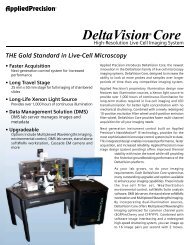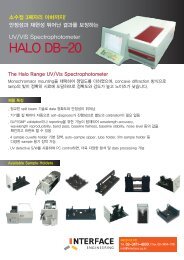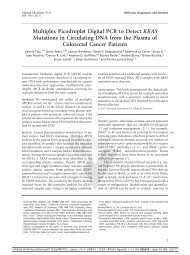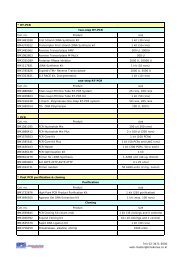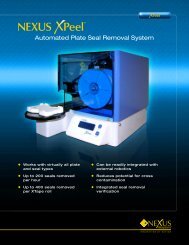DeltaVision OMX brochure.indd
DeltaVision OMX brochure.indd
DeltaVision OMX brochure.indd
You also want an ePaper? Increase the reach of your titles
YUMPU automatically turns print PDFs into web optimized ePapers that Google loves.
How does 3D-SIM work?<br />
The resolution of the microscope is limited by the amount<br />
of spatial information that can pass sucessfully through<br />
the optics. This is represented by the fine grid pattern<br />
in panel 1. If we mix that high-resolution information<br />
with a known signal that we can resolve (panel 2), we<br />
generate a new pattern, the moiré pattern seen in panel<br />
3. Here the pattern that we see is the difference between<br />
the two patterns and can easily be represented without<br />
high-resolution methods.<br />
Likewise, in 3D-SIM, a three-dimensional illumination<br />
pattern is superimposed on the sample. This pattern<br />
generates a new pattern (a moiré pattern) that contains<br />
both the illumination and sample data. By carefully<br />
reconstructing the sample data from the moiré pattern, it<br />
is possible to create a super-resolution three-dimensional<br />
image of the original sample.<br />
Because the illumination pattern is three-dimensional,<br />
the image that is created contains both the lateral<br />
(2D) and the axial (3D) data. This is limited only by<br />
how deep into the sample the illumination pattern can<br />
be maintained before light scattering attenuates the<br />
illumination pattern (usually tens of microns into the<br />
sample). This illumination pattern can be efficiently<br />
generated with multiple excitation wavelengths allowing<br />
multiple fluorochromes can be used in the same sample.<br />
3D-SIM is the only super resolution method that can use<br />
multiple probes in the same sample (currently up to 4)<br />
and that can image well beyond the sample substrate.<br />
panel 1<br />
panel 2<br />
panel 3<br />
conventional<br />
<strong>DeltaVision</strong> <strong>OMX</strong><br />
P53 Binding Protein 1 (P53BP1) at a double-stranded DNA break. Courtesy Gang Bao (Georgia Inst. Technology) and David Spector and Ileng Kurmaran (CSHL).




